
| Photos From Wyoming Tales and Trails This Page: Calvin Coolidge visit to Yellowstone, Governor Emerson sends an invitation by Pony Express. |
 |

| Photos From Wyoming Tales and Trails This Page: Calvin Coolidge visit to Yellowstone, Governor Emerson sends an invitation by Pony Express. |
 |
|
|
|
About This Site |
|
In the summer of 1927, the White House showing its age developed an every increasing leaky roof. Other renovations while the roof was being fixed were found to be desireable. The renovations took some six months. Coolidge had to move out of the White House. A house belonging to Cissy Patterson on Dupont Circle was made available. At the time, Cissy typically stayed in the summer at her Flat Creek Ranch north of Jackson. See Jackson. In the 1920's politicians typically abandoned Washington in the Summer. Thus, President Coolidge using as an excuse the renovations, bugs and crowds of Washington established the Summer White House at the Lodge Custer State Park near Rapid City, South Dakota. President Calvin Coolidge established the summer White House at the Lodge of the Custer State Park near Rapid City, South Dakota. The executive offices were established in Rapid City. The executive offices in Rapid City were connected to Washington by three direct trunk lines. Although, the crowd and the heat of Washington were less, there were still great swarms of photographers and news reporters perched near the President's retreat. Anytime anyone of importance appeared at the presidential retreat the flash bulbs popped and the reporters sped at great speed to the one pay telephone located about a mile away attempting to avoid the motorcycle policeman patroling the road.
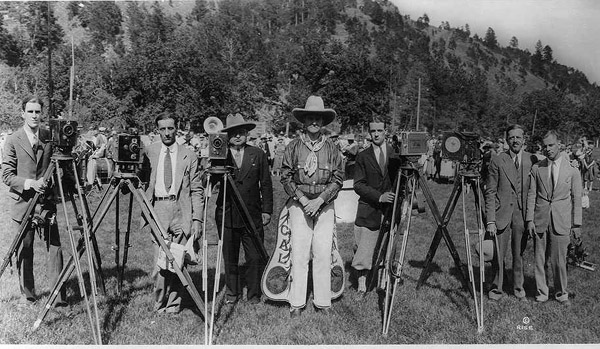 President Coolidge in "cowboy uniform" presented by South Dakotans, uly 4, 1927. Photo by Car H. Rise. On July 4, South Dakotans gave President Coolidge what he referred to as a "cowboy uinform." The swarms of photographers were delighted. It relieved them of the usual boring routine photographs. In the picture to the lower left, Mrs. Coolidge appears somewhat amused.
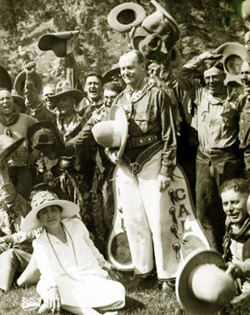 . . . . . . 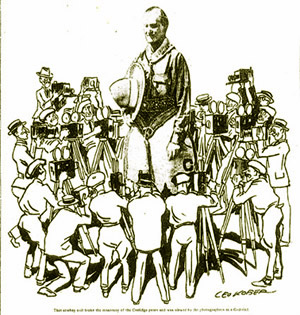 >Left: President Coolidge in new Cowboy Uniform , Photo by Carl H. Rise; Right: Editorial Cartoon, Brooklyn Daily Eagle. The Brooklyn Daily Eagle devoted a half page to newspaper photography. The paper noted that the President does not, on the whole, photograph well and that the presidential pictures were "monotonous." Even while fishing Coolidge, the editorial noted, appears in an ordinary double-breasted suit and wearing an ordinary fedora hat. The paper noted, however, that the outfit was presented as a gift at considerable cost and that the President did not wish to disapppoint. The circus on the President's front lawn was a godsend for tourism in the Black Hills. Newspapers noted that tourists passed by the Summer White House "in seemingly endless streams. The came with their mattresses and hound dogs strapped on the running board. In addition to the cowboy outfit depicted above, the President recieved thirty-five cowboy hats, three pairs of chaps, and red flannel shirts. He also recieved numerous animals including a kangaroo, 2 lions, a bear, a racoon, a peacok, 3 dogs, 2 cats and a pair of rabbits. Wyoming did not wish to miss out on the act.
Not wishing to miss out on the festivities on the President's lawn, in Cheyenne Senator Kendrick and Governor Frank Collins Emerson organized a re-enactment of a Pony Express ride from Cheyenne to the summer White House. Twenty-seven relay riders following the old Deadwood Stage Road would carry an invitation for President Cooolidge to visit Wyoming. Relay riders and fresh horses were stationed every ten miles along the route. On July 11, on the steps of the Capitol, Govenor Emerson delivered the invitation wrapped in a rawhide pouch to the first of the riders, John H. "Butch" Bell (1896-1972) Bell was involved with Frontier Days, was a stock producer for the show, and served for many years as arena director. He later was an important rancher in the Cheyenne area with a ranch at Iron Mountian. At the end of the first run, Bell turned over the pouch to 12 year old Francis E. Warren, II (1914-1982) the grandson of Senator F. E. Warren. It took only two hours forty-five minutes for the invitation to reach Torrington where fourteen year old Clyde Smith passed the Governor's rawhide bundle on to Boone Reid one-half hour of schedule. The half hour saving was not withstandng a purported "holdup" on the outskirts of Torrington. A sheriff's posse of fourty men quickly captured the culprit and the invitation to President Coolidge continued on its way.In Van Tassel, A. H. Peterson picked up the package and carried it to Harrison, where it was turned over for the trip northward. On Tuesday morning Governor Emerson and his Secretary Gregory S. Powell took an aeroplane northward to Rapid City so as to be there when the Pony Express rider would arrive. Shortly after noon rodeo cowboy Clyde "Dakota" Jones hove into sight to deliver the message to the President. Each of the 27 horses, except one, in the run were renamed after famous residents of Wyoming, Nebraska, and South Dakota. The last horse ridden by Jones was named "Calvin Coolidge."
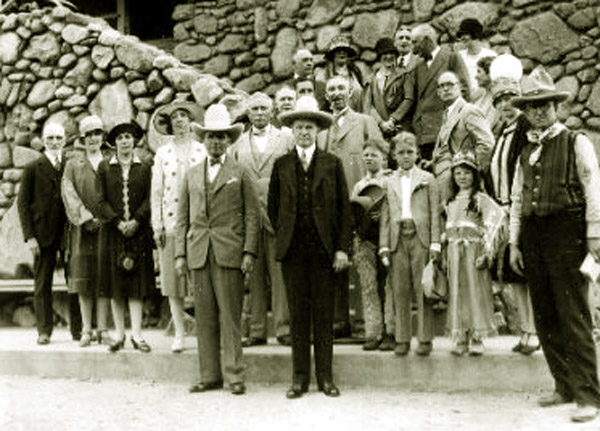 Governor Emerson, President Coolidge and Clyde Jones June 13, 1927.
 Headline, Cody Enterprise, June 15, 1927. Governor Emerson's invitation to visit Wyoming gave rise to gread optimism in Cody that President Coolidge would visit Yellowstone, visit Buffalo Bill's TE Ranch, attend the July 4th Cody Stampede Rodeo, and dedicate the new Buffalo Bill Museum. In actuality, Governor Emerson's invitation was not limited to Cody and Yellowstone. The invitation included Cheyenne's Frontier Days; Sundance; Newcastle, the home of Representative Frank W. Mondell; and the dude ranches of Buffalo and Sheridan. Yet no word came from the Summer White House. The Stampede passed, the Dedication passed and finally in August rumors began that Railroad officials were seen at the Summer White House. Finally, on August 19, the President needing a respite from the canival atmosphere of the Black Hills announced that he would take a brief vacation in Yellowstone beginning two days later on August 21. Reportly, the President was persuaded to go by Mrs. Coolidge and their son John who had been finishing summer school at Amherst. A specific itinerary was not provided other than the President wished to return to the Summer White House the following week in time to attend church.
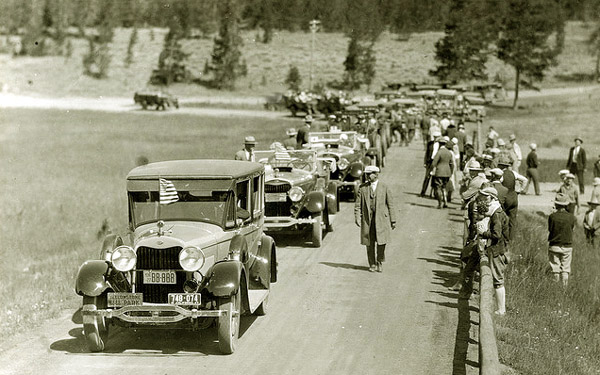 Presidential Motorcade, Yellowstone Park. The first night at the Park, the President stayed at the Executive House owned by Harry W. Child's Yellowstone Park Company. Child also provided the closed car depicted in the above photo. Ten years later President Franklin D. Roosevelt stayed at the same residence when he visited the park.
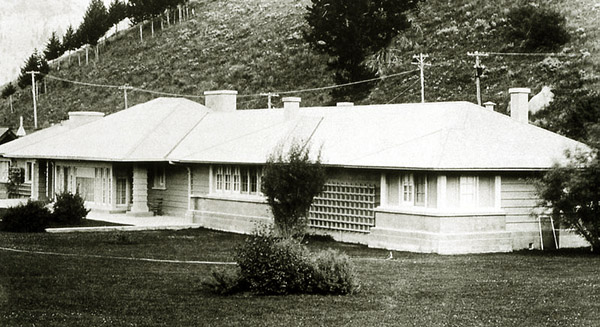 The Executive Residence, Yellowstone Park.
Next Page< Coolidge Visit to Yellowstone continued. |

